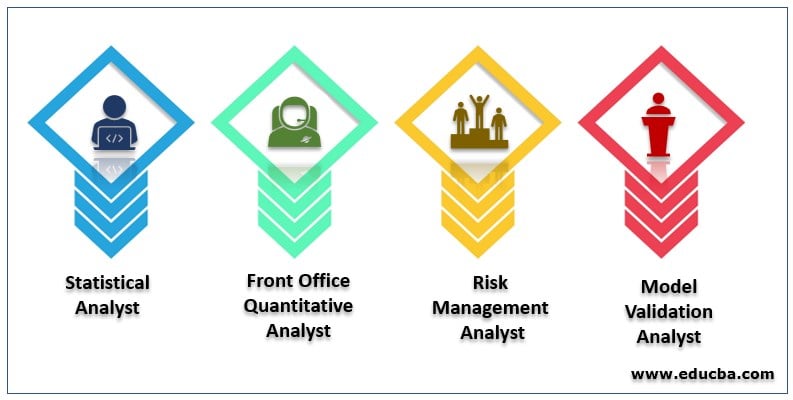Updated July 14, 2023

Overview of Quantitative Analyst Career
The term “quantitative analyst” refers to the professionals who use different quantitative methods to identify profitable opportunities for the business, thus helping in building strategies and making decisions. The term comes from the word “quantitative analysis, ” specifying the procedure researchers and analysts use to transform numerical data into insightful statistical output.
Career in Quantitative Analyst
This article will discuss some of the major job profiles in the quantitative analyst career path that you can pursue. The job profiles are:
1. Statistical Analyst
As a statistical analyst, you will be responsible for providing actionable recommendations for different business aspects to drive its value in the right direction.
Responsibilities
The major responsibilities of a statistical analyst include:
- Mining and transforming the available data into meaningful insights and recommendations for the different business units within the organization
- Finding answers to key business issues by using statistical and analytical techniques
- Processing, cleansing, and verifying the integrity of data employed for analysis
- Analyzing, interpreting & communicating the outcomes to the business units clearly
Educational, Skill, and Experience Requirements
A statistical analyst should have the following education, skill level, and professional background:
- A master’s degree in applied mathematics, statistics, economics, or any other related field is necessary.
- Between 1 to 5 years of professional experience in problems solving using machine learning techniques
- Working knowledge of SAS, SQL, ETL, data processing, data analytics, and database programming, along with Python, R, and MatLab
- Recommended qualifications that are preferable include a master’s in Statistics or CFA.
Salary
In the US, the median annual salary of a statistical analyst is around $65,896, with the highest 10 % earning more than $97,000 while the bottom 10% earning less than $49,000.
Link: https://www.payscale.com/research/US/Job=Statistical_Analyst/Salary
Top Companies
Some top companies that predominantly hire statistical analysts in the US include Investment Banks, NBFCs, Stock Brokers, Mutual Funds, and Hedge Funds.
2. Front Office Quantitative Analyst
As a front office quantitative analyst, your responsibility will be to provide cutting edge solutions for the Capital Markets, which includes Risk Management and Derivatives Trading.
Responsibilities
The major responsibilities of a front office quantitative analyst include the following:
- Conducting micro-level analysis of financial products
- Researching and validating financial product model, which includes both plain vanilla and exotic products
- Following up with the client from notification to resolution and then the validation
- Understanding client business to deliver high-quality solutions within defined timelines
Educational, Skill, and Experience Requirements
A front office quantitative analyst should have the following education, skill level, and professional background:
- A master’s in quantitative finance or mathematics
- Sound knowledge of the financial market
- Working knowledge of SQL and Unix is preferable
- Recommended qualifications that are preferable include a master’s in Statistics, CFA, or CPA.
Salary
In the US, the median annual salary of a front office quantitative analyst is around $84,541, with the highest 10 % earning more than $131,000 while the bottom 10% earning less than $57,000.
Link: https://www.payscale.com/research/US/Job=Quantitative_Analyst/Salary
Top Companies
In the US, some top companies that predominantly hire front office quantitative analysts are Mutual Funds houses, NBFCs, and Stock Brokers.
3. Risk Management Analyst
As a risk management analyst, you will control the organization’s risk, monitor and forecast capital commitments, and optimize trading.
Responsibilities
The major responsibilities of a risk management analyst include the following:
- Monitoring investment positions and collaborating with traders to control risk by optimizing revenue
- Working with a wide range of products, including equities, commodities, etc.
- Amalgamating risk and market data for deriving new performance metrics
- Supporting in improving the organization’s risk tools
Educational, Skill, and Experience Requirements
A risk management analyst should have the following education, skill level, and professional background:
- A bachelor’s degree in statistics, finance, or any other related field
- More than 3 years of professional experience in a trading environment
- Sound knowledge of various financial products, such as options trading
- Recommended qualifications that are preferable include a master’s in statistics, CFA or FRM
Salary
In the US, the median annual salary of a risk management analyst is around $69,026, with the highest 10 % earning more than $102,000 while the bottom 10% earns less than $49,000.
Link: https://www.payscale.com/research/US/Job=Risk_Management_Analyst/Salary
Top Companies
Some top companies that predominantly hire risk management analysts come from Investment Banks, Stock Brokerage firms, and Hedge Funds in the US.
4. Model Validation Analyst
As a model validation analyst, you will be carrying out the validation of various models that are being used within the organization.
Responsibilities
The major responsibilities of a model validation analyst include the following:
- Evaluating the conceptual soundness of models
- Testing appropriateness of input data and correctness of model assumptions
- Identifying the limitations of each model and assessing its overall risk
- Documenting the assessment results as per outlined standards
Educational, Skill, and Experience Requirements
An operational risk analyst should have the following education, skill level, and professional background:
- A master’s degree in quantitative finance, mathematics, statistics, economics
- More than 3 years of experience in either model validation or model development
- Sound understanding of the financial market and products
- Working knowledge of various modeling techniques as well as coding skills
- Recommended qualifications that are preferable include CPA, MBA, or CFA
Salary
In the US, the median annual salary of a model validation analyst is around $84,813, with the highest 10 % earning more than $125,000 while the bottom 10% earning less than $60,000.
Link: https://www.payscale.com/research/US/Job=Model_Validation_Analyst/Salary
Top Companies
Some top companies that predominantly hire model validation analysts in the US include Banks, Mutual Fund houses, and Hedge Funds.
Conclusion
So, it can be seen that the role of quantitative analysts can be very critical for a company’s financial position. So these companies prefer hiring professionals who are specially trained. Consequently, the demand for these professionals is increasing every day, and as such, a career as a quantitative analyst can be very lucrative and professionally satisfying.
Recommended Articles
This is a guide to a Quantitative Analyst Career. Here we discuss some major job profiles in the quantitative analyst career path. You may also look at the following articles to learn more –

